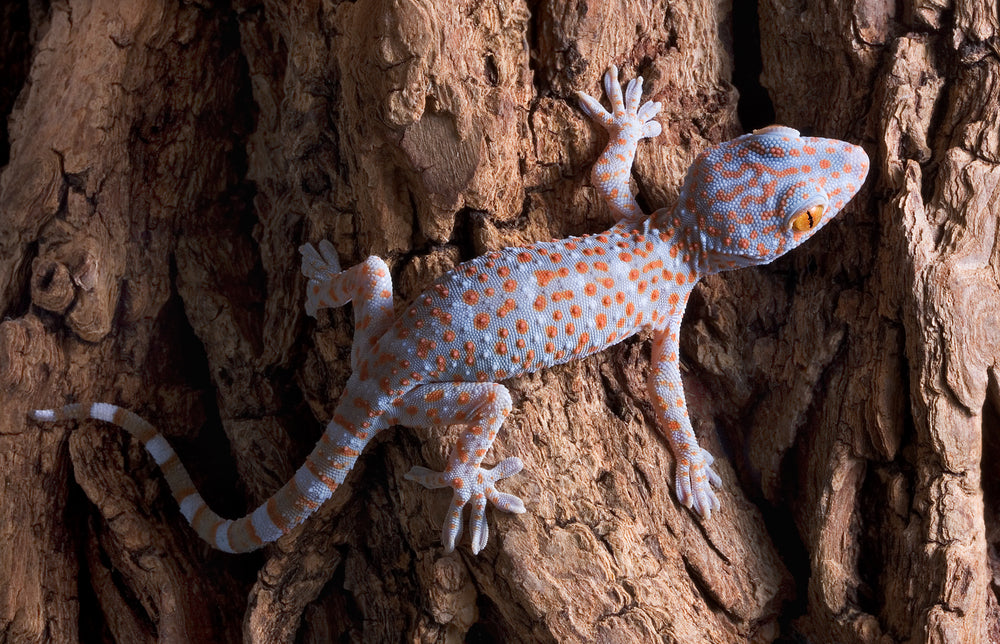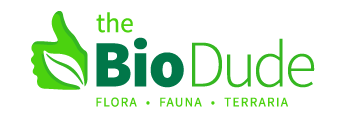Tokay Gecko (Gekko gecko) Care Sheet

Difficulty: Hard
Tokay geckos (Gekko gecko) are large, nocturnal, arboreal lizards. While they are native to southeast Asia, they are invasive in other areas around the world, including Florida (USA), Martinique, and Belize. These geckos prefer tropical forests for habitat, where they hunt insects and small animals for prey. They are also well-known for their habit of taking up residence in human dwellings.
Tokay geckos are among the largest geckos in the world, on average growing 10-12” long, but capable of being as large as 16”. They are thick-bodied, with large lidless eyes, vertical pupils, a rounded triangular head, sharp teeth, and sticky toe pads. They can also be identified by their gray to blue base color overlaid with raised spots which may be orange, red, or even black in color. However, some tokay geckos in captivity have been selectively bred for unusual or more vibrant coloring.
With good care, a pet tokay gecko generally lives 15-20 years. Due to their bold, even aggressive attitudes, this is a pet reptile best suited to more experienced reptile keepers. However, it should be noted that captive-bred individuals are likely to be more docile.
What You Need for a Bioactive Tokay Gecko Enclosure
- Front-opening 24” x 24” x 48” terrarium, or larger
- 50w Arcadia Halogen Heat Lamp, x2
- 40w Exo Terra Ceramic Heater
- Exo Terra Deep Dome Fixture, Small, x3
- Rheostat, x2
- Arcadia ShadeDweller Max UVB ProT5 Kit
- 22” Bio Dude Glow & Grow LED
- Zilla 24/7 Digital Timer Power Center
- Bio Dude Digital Thermometer / Hygrometer, x2
- Exo Terra 2qt Mister
- Terra Fauna Bioactive Kit 18 x 18 x 18/24, x2
- Bio Dude Crested Gecko Clean Up Crew Pack
- Crested Gecko Starter Plant Pack, x2
- Vines
- Ghostwood and/or cork branches
- Pangea Mini Gecko Feeder Magnetic Ledge, x1
- Miner-All Indoor Calcium Powder
Terrarium Size
The minimum enclosure size we recommend for housing a single tokay gecko is 24” L x 24” W x 48” H. However, when it comes to choosing a terrarium for pet reptiles, keep in mind that larger is always better! Tokay geckos are large and quite active, so it’s very important to give them plenty of room to explore, exercise, and hunt.
Tokay geckos should not be housed together unless for breeding purposes.
Lighting
Although they are a primarily nocturnal (night-active) species, tokay geckos should still have access to appropriate UVB lighting for optimal health. Aside from enabling vitamin D3 synthesis, access to UVB lighting offers benefits such as preventing illness, improving nervous and digestive function, and improving mental health.
In other words, we recommend installing high-quality, fluorescent tube UVB lighting as part of your tokay gecko’s setup. For best results, use a 24” Arcadia ShadeDweller Max UVB unit. For safety, place the lamp on top of the enclosure mesh and place the basking branch 4-8” directly below.
Your UVB bulb must be replaced every 12 months to maintain its output. We do not recommend using other UVB bulbs for this setup unless you have a Solarmeter 6.5 to ensure a basking UVI of 1.0-2.0.
Because this is a bioactive setup, you will also need a plant light to encourage healthy plant growth. The extra illumination is also beneficial for further simulating sunlight! We recommend the 22” Bio Dude Glow & Grow LED for this purpose — and don’t worry, it’s not too bright for your gecko. This lamp may seem bright, but it’s still nowhere close to real sunlight!
Your lamps should be on for 12 hours/day, or synced with your local sunrise/sunset times.
Heating
Like other reptiles, tokay geckos are poikilothermic, which means that they need a range of temperatures within their enclosure so they can regulate their own body temperature as needed. Areas of heat speed up their metabolism and promote activities like digestion and healing. Cool areas slow the metabolism and promote activities like rest and energy conservation.
Target this temperature gradient for your tokay gecko:
- Basking area: 90-100°F
- Shade: 80-85°F
- Nighttime: 76-80°F
To create a basking area for your tokay gecko, you will need a low-wattage halogen flood bulb (two for large geckos) like the 50w Arcadia Halogen Heat Lamp and a fixture like the small Exo Terra Deep Dome Fixture. If the basking area gets too warm, you can plug the lamps into a rheostat and dial down the heat that way. If the basking area is too cool, you will need a higher-wattage bulb.
Because tokay geckos require higher nighttime temperatures than what is available in the average home, you will need a lightless heat source for use at night. A ceramic heat emitter or heat projector, plugged into a lamp dimmer or thermostat will help make sure your tokay’s environment is always comfortable. This heater should be turned off during the daytime.
To track the temperatures in your terrarium, you will need at least two digital probe thermometers like the Bio Dude Digital Thermometer / Hygrometer. Place one probe in the basking area and the other in a shady spot lower in the setup. You can do this easily by zip-tying each probe to a branch or plant!
Humidity
Tokay geckos need a high-humidity environment. To be specific, they need an average of 60-80% humidity, wetter at night and drier during the day. Keep track of your humidity levels with a digital hygrometer like the Bio Dude Digital Thermometer / Hygrometer, with the probe secured to a branch in the middle of the enclosure, preferably in a shaded area.
To raise the humidity in your gecko’s enclosure and provide a source of drinking water, use an Exo Terra 2qt Mister to wet things down every morning and evening, preferably when it’s dark. If you need help increasing humidity, you can run a fogger/cool mist humidifier with distilled water at night. If your setup is a bit stagnant, try adding a 4” USB fan.
Substrate
A thick layer of bioactive-compatible substrate is essential to creating a successful bioactive tokay gecko enclosure.
First, pour approximately 2” of clay balls or Bio Dude HydroGrow drainage material on the bottom of the enclosure. Then, place a layer of tight mesh on top to help prevent soil from getting into the drainage layer.
Next, you will need a soil-like mix that mimics the conditions of a tropical forest and will nourish your plants. If you want to make your own, you will need a mixture of 50% organic topsoil, 25% peat moss, and 25% play sand, measured by volume. Mix that with leaf litter, sphagnum moss, and an appropriate amount of Bio Shot to inoculate your soil with beneficial microfauna. This layer of soil should be as deep as possible.
Alternatively, you can let The Dude do the work for you with two Bio Dude Terra Fauna 18x18 bioactive substrate kits!
To make the substrate functional, make sure to add tropical CUC organisms like powder blue/orange isopods, dwarf white isopods, and springtails. You can also add other species like superworms, earthworms, and millipedes!
For best results, let your plants and CUC get established for at least one month before introducing your gecko to the setup. This is also a good time to make sure you have the right temperatures and humidity.
Decorating the Enclosure
Enclosure décor is more than just making your setup look good. It’s also an important part of providing environmental enrichment to your gecko, which enhances your pet’s quality of life by providing opportunities to express natural behaviors. Considering that tokay geckos are arboreal, two of their most important natural behaviors are climbing and hiding, which means that you will need lots of branches, vines, and foliage to fulfill that need. Don’t be afraid to clutter it up, but make sure there’s some open space for basking and jumping.
Live plants in particular are critical to helping your mini-ecosystem function properly. You can’t have a fully functioning vivarium without live plants!
Feeding Your Tokay Gecko
Tokay geckos are carnivorous. Specifically speaking, they primarily feed on insects and small animals such as cockroaches, grasshoppers, centipedes, frogs, lizards, and snakes in the wild. Here is a quick feeding schedule you can reference:
- Hatchlings and Juveniles — daily
- Adults — every other day
Offer as many insects as the gecko will eat in a 5-minute period, no larger than the gecko’s head.
The key to providing a healthy, balanced diet for any reptile is VARIETY! Here’s a quick list of foods that are safe to feed to your gecko:
Best insects: crickets, grasshoppers, dubia roaches, discoid roaches, hornworms, silkworms
Pinky mice, crested gecko diet, and feeder lizards (ex: house geckos, anoles) should be offered no more than 2x/a month as nutritious treats.
Supplements
Although feeder insects should be gut-loaded with a specially formulated insect gut load diet like Repashy Superload or Arcadia InsectFuel for 48 hours prior to feeding, they will also need to be “dusted” with an appropriate supplement powder just before. There are many options, but MinerAll Indoor and the Arcadia Earthpro supplement regime are both solid choices. For best results, use as directed by the label.
Water
Although your gecko will get most of its water from daily mistings, it’s best practice to always keep a clean cup of water available. Tokay geckos prefer to drink up off the ground, so use a gecko cup in a magnetic ledge.
Care information courtesy of ReptiFiles.
- Rebekah Walenta








